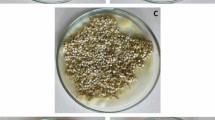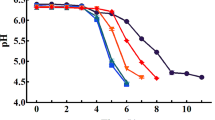Abstract
Hibiscus cannabinus L. or commonly known as kenaf is a multipurpose crop with various medicinal and nutritional properties. The aim of this study was to determine the antioxidant, nutritional, and functional properties of kenaf leaves powder. In addition, the effect of kenaf leaves powder fortification in bread properties and consumer acceptability were evaluated by production of three formulations of bread with 0% (control), 4% and 8% substitution of kenaf leaves powder per weight of flour used. From the sensory evaluation, 4% leaves powder bread was the most preferred by the panelists followed by 0% leaves powder bread then 8% leaves powder bread. Therefore, 4% leaves powder bread was chosen as the best formulation for this study and it showed significantly higher value of DPPH free radical scavenging capacity (8.05 mg TE/100 g), total phenolic content (12.9 mg GAE/100 g) and total flavonoid content (13.3 mg QE/100 g) compared to control bread (1.38 mg TE/100 g, 8.17 mg GAE/100 g and 8.77 mg QE/100 g, respectively). Besides, 4% leaves powder bread also showed improvement in calcium and total dietary fibre compared to control bread. Given these results, kenaf leaves powder can be used in baking formulation up to 4% with flour to enhance the functional properties of baking formulation without compromising eating quality.

Similar content being viewed by others
References
N. Kaur, D.P. Singh, Appetite 112, 167–187 (2017)
M. Jridi, O. Abdelhedi, H. Kchaou, L. Msaddak, M. Nasri, N. Zouari, N. Fakhfakh, Food Biosci. 31, 100436 (2019)
S. Patil, S. Rudra, E. Varghese, C. Kaur, Food Biosci. 14, 62–69 (2016)
D. Kubmarawa, I.F. Andenyang, A.M. Magomya, Afr. J. Biotechnol. 3(9), 233–236 (2019)
K. Hosomi, Y. Washio, T. Morishita, H. Inagaki, JISDH 15(1), 54–60 (2004)
A. Pascoal, R. Quirantes-Piné, A.L. Fernando, E. Alexopoulou, A. Segura-Carretero, Ind. Crops Prod. 78, 116–123 (2015)
G.A. Agbor, J.E. Oben, B. Nkegoum, J.P. Takala, J.Y. Ngogang, PJBS 8(10), 1397–1401 (2005)
AOCS, Official Methods and Recommended Practices of the American Oil Chemists’ Society (American Oil Chemists’ Society, Champaign, 1997)
AOA, AOAC: Official Methods of Analysis, 15th edn. (AOA, Washington, D.C., 1990)
N. Uzoekwe, J. Mohammed, JASEM 19(4), 633–637 (2015)
K.L. Nyam, M. Lau, C.P. Tan, Malays. J. Nutr. 19(1), 99–110 (2013)
C.W. Jin, A.K. Ghimeray, L. Wang, M.L. Xu, J.P. Piao, D.H. Cho, J. Med. Plant Res. 7(17), 1121–1128 (2013)
S. Cao, C. Wan, Y. Yu, S. Zhou, W. Liu, S. Tian, Pharmacogn. Mag. 7(25), 40 (2011)
X. Liu, M. Zhao, J. Wang, B. Yang, Y. Jiang, J. Food Compos. Anal. 21(3), 219–228 (2008)
C.M. Rosell, E. Santos, P.J.M. Sanz, M. Haros, J. Cereal Sci. 50(2), 272–277 (2009)
A. Sangnark, A. Noomhorm, Food Chem. 80(2), 221–229 (2003)
V.O. Alfredo, R.R. Gabriel, C.G. Luis, B.A. David, LWT - Food Sci. Technol. 42(1), 168–173 (2019)
A. Abdul-hamid, Y.S. Luan, Food Chem. 68(2000), 15–19 (2000)
AACC, Approved Methods of American Association of Cereal Chemists, 10th edn. (American Association of Cereal Chemists, Inc, Minnesota, 2000)
K.L. Nyam, S.Y. Leao, C.P. Tan, K. Long, J. Food Sci. Technol. 51(12), 3830–3837 (2012)
M. Nasir, M.S. Butt, M.A. Faqir, K. Sharif, R. Minhas, Int. J. Agric. Biol. 5(4), 458–459 (2003)
H.A. Abdul, S.A. Aziz, N.A. Sadat, T.T. Su, N.A. Mohd, M.Y. Jalaludin, FASEB 31(1 Supplement), 303–303 (2017)
S.B. Kakade, V.S. Neeha, IJRITM 1(8), 58–64 (2014)
E. Kipriotis, X. Heping, T. Vafeiadakis, M. Kiprioti, E. Alexopoulou, Ind. Crops Prod. 68, 126–130 (2015)
J. Ryu, S.J. Kwon, J.W. Ahn, Y.D. Jo, S.H. Kim, S.W. Jeong, M.K. Lee, J.B. Kim, S.Y. Kang, Plant Biotechnol. J. 44(2), 191–202 (2017)
H.B. Sowbhagya, P.F. Suma, S. Mahadevamma, R.N. Tharanathan, Food Chem. 104(3), 1220–1225 (2007)
J. Xu, W. Wang, Y. Li, J. Funct. Foods 52(2018), 629–639 (2019)
M. Świeca, L. Seczyk, U. Gawlik-Dziki, D. Dariusz, Food Chem. 162(2014), 54–62 (2014)
P.O.P. Anamaria, G.S. Petrut, A.P.A. Ucean, C.M.S. An, L.C. Salanta, S. Man, Hop Med. Plants 1, 37–44 (2016)
B.W. Kim, K.I. Sung, J.G. Nejad, J.S. Shin, J. Korean Soc. Grassl. Forage Sci. 32(4), 353–360 (2012)
L. Das, U. Raychaudhuri, R. Chakraborty, Food Technol. Biotech. 9862(3), 434–440 (2013)
Z. Fu, M.J. Yoo, W. Zhou, L. Zhang, Y. Chen, J. Lu, Food Chem. 242, 162–168 (2018)
Malaysian Food Composition Database (Malaysian Food Composition Database (MYFCD), 1997). https://myfcd.moh.gov.my/. Accessed 17 Mar 2019
Funding
Financial support of this work by the Ministry of Higher Education through the Fundamental Research Grant Scheme (FRGS/1/2018/WAB01/UCSI/02/1) is gratefully acknowledged.
Author information
Authors and Affiliations
Corresponding author
Ethics declarations
Conflict of interest
The authors confirm that they have no conflicts of interest with respect to the work described in this manuscript.
Additional information
Publisher's Note
Springer Nature remains neutral with regard to jurisdictional claims in published maps and institutional affiliations.
Rights and permissions
About this article
Cite this article
Lim, P.Y., Sim, Y.Y. & Nyam, K.L. Influence of kenaf (Hibiscus cannabinus L.) leaves powder on the physico-chemical, antioxidant and sensorial properties of wheat bread. Food Measure 14, 2425–2432 (2020). https://doi.org/10.1007/s11694-020-00489-y
Received:
Accepted:
Published:
Issue Date:
DOI: https://doi.org/10.1007/s11694-020-00489-y




